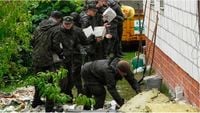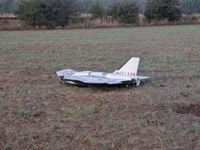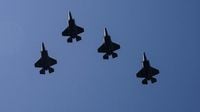On September 13, 2025, the skies above Eastern Europe were anything but quiet. As Russian drone and missile attacks intensified against Ukraine, NATO allies Poland and Romania found themselves scrambling fighter jets and raising their defenses to the highest alert in response to a series of incursions that have rattled the alliance and exposed cracks in its collective security posture.
According to ABC News, the latest episode began when Polish military authorities detected Russian drone activity near their border with Ukraine. Polish Prime Minister Donald Tusk announced that, in response to "the threat posed by Russian drones operating over Ukraine near the border with Poland," the country's air defenses "reached the highest state of readiness." Polish and allied aircraft, including F-16s and Dutch F-35s, were deployed to patrol the airspace, and ground-based air defense and reconnaissance systems were put on the highest alert. The Associated Press reported that Lublin Airport in eastern Poland was temporarily closed due to military aviation activity, underscoring the seriousness of the situation.
That same day, the Romanian Ministry of Defense reported that a Russian drone violated Romanian airspace while attacking Ukrainian infrastructure along the Danube River—a critical border between Romania and Ukraine. Two F-16 fighters were scrambled, tracking the drone as it penetrated approximately 20 kilometers southwest of Chilia Veche before disappearing from radar. The Romanian Defense Ministry told ABC News that the drone "did not fly over populated areas and did not pose an imminent danger to the safety of the population." Preliminary reports suggested the drone ultimately flew back into Ukraine, and a search team was dispatched to look for possible debris.
This was not an isolated incident. According to data provided to ABC News by the Romanian Defense Ministry, the September 13 violation marked the eleventh time a Russian drone had breached Romanian airspace since Moscow’s full-scale invasion of Ukraine began in February 2022. A ministry spokesperson noted that there have been around 50 Russian drone attacks near Romania’s borders, with drone debris falling onto Romanian territory in 30 cases. In ten instances, Russian drones "briefly penetrated Romania’s airspace."
Romanian Defense Minister Ionut Mosteanu minced no words in his condemnation, posting on X that Bucharest "condemns Russia’s reckless behavior, which threatens regional stability. Together with our NATO allies, we remain vigilant and ready to defend every inch of allied airspace."
Poland, too, has not been spared. Just three days earlier, on September 10, Polish authorities confirmed that 19 Russian drones had violated their airspace during coordinated attacks on Ukraine. According to The Asia Business Daily and Reuters, the Polish Air Force, supported by Dutch F-35s and Italian AWACS, shot down at least four drones. The incident marked the first time since the onset of the full-scale war that NATO members fired on Russian targets. The situation was deemed so serious that Poland activated Article 4 of the NATO treaty, allowing member states to demand urgent consultations when their territorial integrity or security is threatened. The Dutch, Italians, and Germans all contributed assets to support the interception operation, and NATO subsequently launched a new mission dubbed "Eastern Sentry."
President of Poland Karol Nawrocki signed a resolution permitting NATO forces to reinforce Poland under the framework of the 'Eastern Sentry' operation, as confirmed by the country's National Security Bureau. While the specifics of the resolution remain classified, its significance is clear: Poland is seeking robust support from its allies as the eastern flank of NATO faces increasing pressure from Russian military activities.
Ukraine’s President Volodymyr Zelenskyy added his voice to the chorus of alarm, stating on X that the Russian drone which violated Romanian airspace on September 13 operated about six miles inside NATO territory for around 50 minutes. "The Russian military knows exactly where their drones are headed and how long they can operate in the air," Zelenskyy wrote. "Their routes are always calculated. This cannot be a coincidence, a mistake, or the initiative of some lower-level commanders. It is an obvious expansion of the war by Russia -- and this is exactly how they act. Small steps at first, and eventually big losses."
Romania, for its part, has responded by adopting a "completely new legislative approach" to drone threats, as a Defense Ministry spokesperson explained to ABC News. This includes both non-kinetic measures (such as taking control of drones via specialized devices) and kinetic ones (destroying drones outright). "The aircraft that cannot be neutralized by non-kinetic measures may be destroyed, depending on the level of threat, if there is a real danger to national security, the people’s lives or property," the spokesperson said. Despite these new measures, Romania has yet to shoot down a Russian drone, while Poland and its allies have demonstrated a more forceful response.
The incidents have not only tested military readiness but also exposed political and diplomatic fissures within the alliance. Reuters reported that US President Donald Trump’s initial reaction to the September 10 drone incursion was notably restrained. On Truth Social, Trump posted, "What’s with Russia violating Poland’s airspace with drones? Here we go!" and later suggested, "it could have been a mistake." This response, coupled with the absence of US warplanes in the interception, sparked anxiety among European allies. A senior German official told Reuters, "With this US administration, we can’t rely on anything. But we have to pretend that we could." An Eastern European diplomat described Washington’s response as "almost deafening" in its silence, while an Italian official said the impression among allies was largely negative.
The contrast with previous US crisis management was stark. When a Russian missile was believed to have struck a Polish village in November 2022, then-President Joe Biden quickly convened emergency meetings with world leaders. This time, the response was muted, and the burden of military action fell on European allies. NATO Secretary-General Mark Rutte tried to project unity, announcing plans to strengthen the alliance’s eastern flank and stating that Trump had made "absolutely clear that we all stand together on this." Still, the episode left lingering doubts about the depth of US commitment to European security.
In the wake of the drone incursions, Sweden delivered air defense systems and fighter jets to Poland, reinforcing the alliance’s resolve to bolster its air defenses. Meanwhile, the air war raged on: Ukraine’s air force reported that Russia launched 58 drones and one missile overnight into September 14, with air defenses downing or suppressing 52 drones. The Russian Defense Ministry, for its part, claimed to have downed at least 103 Ukrainian drones overnight.
As the dust settles, the message from Eastern Europe is clear: the region is on edge, NATO’s eastern flank is under constant scrutiny, and the alliance’s ability to respond swiftly and cohesively is being tested like never before.






